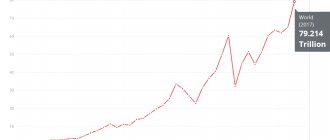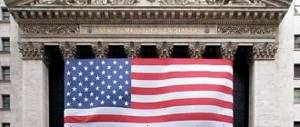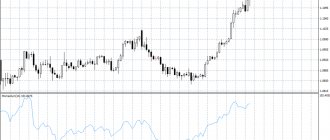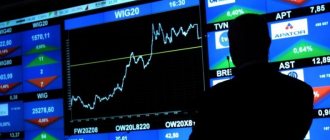If you sum up the stock prices of all the companies in the world, you technically get the market capitalization of planet Earth. So, in just a few months, the capitalization of the world stock market soared to $80 trillion, and continues its systematic movement towards the $100 trillion mark*.
The main points are:
- The capitalization of the global stock market exceeded $80 trillion;
- Such a long “bullish” trend – almost 9 years – took place even before the “Great Depression”;
- Goldman Sachs is convinced that the overall dominance of the bull market is nearing its end;
- According to Goldman Sachs, in the medium term we could expect either a protracted crisis or a sharp collapse in the securities market.
World market capitalization
What's troubling about such rapid progress is that the growth line has been steadily rising throughout 2021. Up to this point, global market capitalization had been like any other stock index: a series of gradual price increases over time, with a pronounced collapse during the 2008 financial crisis and subsequent economic recovery.
In 2021, the graph looked like a straight line moving upward without deviations.
The bond market sometimes makes losses too
Holders of long OFZs lost on average about 4% of their portfolio value in August. What is happening and what should an investor do in today's situation?
The Russian government bond market in 2021 came under pressure from American sanctions, the threat of which provoked massive sales of bonds by non-residents and an increase in yields on the sovereign debt market.
The RGBI government bond index continues to decline rapidly after peaking in April. The most depressing period was August, when once again a bill was introduced into the US Congress that included restrictions on transactions with the new Russian government debt.
The index of federal loan bonds (OFZ), one of the most low-volatility and highly reliable instruments on the Russian stock market, lost a little more than 4% during this period.
The Moscow Exchange Government Bond Index is the main indicator of the Russian government debt market. It includes the most liquid Federal Loan Bonds with a duration of more than one year.
Three-year OFZs, purchased at the beginning of the year at a yield of about 7%, are currently losing about 3.5%, which completely negates the entire semi-annual coupon income. Longer-term securities generally turned out to be unprofitable for investors due to greater sensitivity to rising interest rates.
Investors in high-duration corporate bonds also suffered losses, especially among holders of issues of securities of issuers close to the state, who are in the forefront among applicants for US sanctions.
At the same time, the credit risk of the Russian Federation remained at the same level. The size of the government debt is at comfortable levels, oil prices allow us to count on a budget surplus in 2018-2019, and gold and foreign exchange reserves have increased since the beginning of the year and amounted to $458 billion as of August 1.
Why did investors suffer such significant losses?
The so-called interest rate risk was realized - the risk of fluctuations in the market value of a bond in response to changes in the level of interest rates in the economy.
The level of interest rates in the economy is influenced by many factors. In this case, the key role was played by the high share of non-residents among OFZ holders, which amounted to 33.1% at the beginning of the year, and on April 1 reached its maximum of 34.5%.
Due to the extremely low levels of interest rates in the developed markets of Europe and the United States, the high yield of Russian OFZs opened up excellent prospects for non-residents for carry trade operations, which contributed to the rally in the Russian government bond market from the beginning of 2021 to April 2021.
Carry trade is a strategy for making profit due to differences in interest rates. Roughly speaking, an investor borrows money in dollars at 2%, converts it into rubles and invests it at 7%. If the dollar/ruble exchange rate remains at the same level, the investor’s income will be 5% per annum. But if the dollar in rubles rises, the investor may find himself at a loss.
American congressmen announced possible sanctions against Russian sovereign debt back in the summer of 2021. However, among foreign holders of Russian debt there were many American investors who could suffer due to such restrictions, so the market assessed the likelihood of sanctions as low. These beliefs were strengthened even more in January-February 2021, when the US Treasury announced that there were indeed no plans to impose sanctions on government debt in the near future, although the US had not completely abandoned this idea.
However, some new restrictions were introduced and hurt the country's stock market in other ways. The sanctions imposed in early April hit Russian public company Rusal for the first time, causing its shares to fall more than 30% in a few days, and the company's management warned creditors of the possibility of a technical default on its obligations.
These events forced not only OFZ holders, but also all foreign investors to reassess the risks of investing in Russian assets. The massive outflow of foreign capital from the Russian market also put pressure on the Russian ruble, which lost about 9% against the dollar in April.
A decrease in the profitability of carry-trade operations due to the falling ruble and the prospects for a tightening of the Fed’s monetary policy, as well as the threat of more severe sanctions against Russia, provoked all the “hot capital” that had previously flown into OFZs to stand in line “to exit.”
Outflows of non-residents from government bonds of the Russian Federation were observed for 3 months in a row from April to June, and only in July they slowed down against the backdrop of optimistic expectations from the meeting of the presidents of Russia and the United States. But the expectations were not met.
In early August, sanctions on Russian government debt again appeared in a congressional bill, this time supplemented by proposals to ban dollar transactions for Russian state banks. Statements about the continuation of the sanctions policy were supported by real actions introducing a number of restrictions on trade with the Russian Federation at the end of the month.
Against this external background, the RGBI index entered its longest unrecoverable fall since 2014 for 14 trading sessions in a row. Having lingered slightly around 134 points, the index continued to decline again this week after the head of the Central Bank, Elvira Nabiulina, announced the emergence of factors that, if the situation worsens, may well lead to an increase in the key rate.
What should an investor do?
As noted above, the likelihood of a default in the Russian Federation is still completely absent, which is also true for many corporate issuers. (This means that the sanctions themselves did not significantly affect the solvency of the companies subject to restrictions.)
Therefore, for those who initially planned to hold securities until maturity, nothing has changed significantly. Holders of short issues that have fallen slightly in price may want to look at slightly longer securities that offer higher yields but still fall within the required investment horizon.
Things are more complicated for holders of long issues with a constant coupon, who planned to sell them before maturity. For them, the question now is particularly acute: to cut risks and fix losses, moving to shorter securities, or to leave everything as is.
Essentially, this problem can be boiled down to the question of whether market returns will continue to rise. Forecast inflation values for 2018-2019. are still close to the Central Bank's target of 4-5%, so real interest rates remain stably in positive territory.
The US sanctions policy looks less predictable. Based on the actions already taken by the states in this direction, it can be assumed that they will continue to methodically increase pressure on the Russian Federation. This means that with a certain frequency we will see the introduction of new sanctions; the only question is the frequency and severity of new measures.
Thus, while there is a high degree of uncertainty on the horizon, in each case it is necessary to proceed from the specific features of the situation: goals, risk tolerance, investment horizon, etc. One of the strategy options could be expanding the investment horizon, or reducing the level of portfolio duration to the required period for return of invested funds.
It makes sense for new investors to primarily focus on short-term issues, while being sure to evaluate the total duration of the portfolio. For investors with minimal risk tolerance and/or those looking forward to a longer investment horizon, it makes sense to take a closer look at securities with floating interest rates or indexed denominations. Among such government bonds, OFZ-IN linkers can be noted.
In addition, do not forget to pay attention to offers for corporate bonds, which allow you to present the paper for redemption before maturity and reduce the duration of the issue.
BCS broker
In the medium term, either a protracted crisis or a sharp collapse is expected
International analyst Christian Müller-Glissmann and his colleagues at Goldman Sachs believe that the overall dominance of the bull market will soon end: “Average quantile valuations of stocks, bonds and loans are the highest since 1900,” they write, and this will lead to the two most likely scenarios: a protracted crisis or a sharp stock market crash, leading to a bear market.
They base their analysis on a 60/40 investment portfolio, which means 60% of the investment is in the S&P 500 index and the remaining 40% in government bonds—a typical mix found in private pension funds, mutual funds, and also for a 401(k) retirement plan. In other words, these are the type of investments you're likely to rely on in retirement. Government bonds are commonly used as a security hedge because when stock prices fall, the bonds often retain their value.
The debt market is shrinking
For the bond market, 2021 was divided into periods before and after April 6, when the United States imposed sanctions against a number of Russian companies and businessmen. This led to a collapse in the stock market and a depreciation of the ruble, but in these markets the panic ended within a few days. But the bond market experienced a longer-term negative effect - the number and volume of placements of new securities decreased noticeably.
Sergey Lyalin, CEO of the Cbonds group of companies, called 2021 the worst year for the bond market in the last 6 years. “After sanctions were adopted against Rusal in April, this market stopped altogether for six months,” he notes. — Then some sprouts appeared. There was placement of Gazprom and RusHydro. There was an placement of securities of the sovereign (the Ministry of Finance of the Russian Federation - Ed.) in euros. However, the total volumes are extremely small. As a result, the volume of the corporate Eurobond market decreased to about $110 billion. At this rate, next year we will go below $100 billion.”
According to Sergei Lyalin, only the OFZ segment has increased in the domestic market this year. It grew by 8%, to 7.3 trillion rubles. Companies placed significantly less ruble bonds than last year. Over 11 months, the volume of money raised in this way amounted to 1.26 trillion rubles. Compared to 2021, the drop is more than 2 times.
Warn before you punish. Head of the Central Bank Consumer Rights Protection Service about complaints and misselling Interview
Industry indices
Processes in individual sectors of the economy are reflected in the dynamics of industry indicators. They include the most liquid securities of the largest corporations by capitalization. MOEX presents 9 industry indicators, calculated both in Russian rubles and in US dollars. For example, MOEXOG Oil and Gas Index, MOEXEU Electric Power Index - in rubles; RTSOG, RTSEU - in dollars, respectively. MOEXOG ( oil and gas ) is the largest in terms of capitalization - 1,419,938,076,109 rubles . Includes securities of 13 leading companies in the industry. The shares of Gazprom, Lukoil, Novatek, Rosneft and Tatneft have the greatest weight. MOEXFN - finance . The most significant influence on the dynamics of the indicator is exerted by securities of Sberbank, VTB Bank, and Moscow Exchange. The third position in terms of capitalization is occupied by shares of the mining industry included in MOEXMM (RTSMM). Securities of ALROSA JSC, MMC Norilsk Nickel, Raspadskaya, Mechel, RUSAL plc play a leading role in this sector.
Dynamics of the main industry stock indices
A separate group on MOEX presents thematic indices - indices of the public sector , innovation and the Moscow Exchange Index 10. More information about indices of other regions of the planet can be found here.
Finance and Banking
Here the state tentacles feel at ease, controlling a significant part of the domestic financial sector through state banks. Sberbank and VTB can, if necessary, count not only on financial support, but also on special preferences in regulating their activities.
Risks for investors in this industry are associated with the outflow of foreign capital from Russia, which often begins with the fall of shares of the country's largest banks. In addition, neither Sberbank nor VTB can boast of such a presence in the international market as oil and gas companies have. This also does not add to their investment attractiveness.
Top largest stock exchanges by capitalization
There are a huge number of exchanges in the world offering their brokerage services for business capitalization and the sale of securities. I won’t list everything, here are the top 3 to understand what huge sums they are handling.
The USA, as always, is ahead of the rest: all world financiers give the first place to the New York Stock Exchange (NYSE). According to statistics for 2021, its daily turnover in the sale of securities is $1.5 billion.
Second place also goes to the Americans. Another big name familiar to everyone who is even slightly involved in finance is NASDAQ. Its daily turnover is $1.3 billion.
The third place is taken by the Japanese JPX exchange with a trading turnover of $0.5 billion.
As you can see, the capitalization of global companies is in full swing.
How to access these exchanges
Trading on the Russian securities market is possible after concluding an agreement with a local brokerage company, where you will be offered to use the services of a stock broker. This can be done without leaving home on the website or on the Gosuslugi portal.
Do you want to trade on Western markets? There is a condition: you must obtain the status of a qualified investor. The easiest way is to have 6 million rubles in your account, if, of course, you have them.
Don't have that amount? In this case, stock up on certificates of a professional market participant of the Federal Financial Markets Service, CFA, or access to American securities will be severely limited.
Caution about BO and Forex
Expert opinion
Vladimir Silchenko
Private investor, stock market expert and author of the Capitalist blog
Ask a Question
Something that many people fall for without knowing all the intricacies of the financial world. From the computer screen, various companies, under the guise of brokerage houses, are offering me mountains of gold. Unfortunately, in our world not everything is so simple. Companies like Forex and BO are just scammers. Why? Here is the answer.
Forex is an interbank currency market, and not a representative of the world bank, as many may think. If I want to buy shares or securities, for example, Apple, then they simply are not there. Although it is possible to purchase foreign currency, this is the main and only specialization of this organization.
BO, or binary option, is a casino that very successfully pretends to be the stock market, taking advantage of people’s ignorance and gullibility. You definitely shouldn’t hope to buy securities there.
The main problem is that all these organizations are not controlled by the state in any way, preventing people from earning money, deceiving them into spending it nowhere, enriching these scammers. The rule that the casino always wins also applies to their online versions.
Bond yield forecast in 2021
I suggest you familiarize yourself with the forecast I compiled. Please consider the following:
— the quote changes constantly, therefore, the value of a security indicated in % may slightly differ from the actual figures;
— when buying a bond on the secondary market, you will need to pay not only its market value, but also the accumulated coupon income ( ACI ).
• Long OFZ
Securities with a maturity date of 5 years or more that can be purchased and “ forgotten ” because the investor will receive the entire previously guaranteed return by the specified maturity date.
• Short OFZ
These include government debt securities that mature within 5 years. Well, my classification in this case is a little different from the generally accepted one. After all, short bonds are usually called bonds whose maturity is about 3 years.
Unlike long-term securities, short-term securities of this type are distinguished by higher resistance to crisis phenomena. Their quotation is not so dependent on the economic situation. But this comes at a cost - their profitability is lower .
• Municipal bonds
Most municipal bonds are traded at amortization. The issuer, in this case, carries out a gradual redemption of the body of the security. Because of this, their profitability gradually decreases, because coupon income is calculated as a percentage of the current denomination.
At current key rates, investing in amortizing bonds does not provide a high return. For an investor who prefers to purchase securities for a long time, this option is not suitable, since it is necessary to invest the money received from the issuer in new assets.
However, municipal securities have a higher yield to maturity than OFZ . And the risk levels are comparable .
• Corporate bonds of state and quasi-state companies
Here I included bonds of state-owned companies ( more than 50% of shares belong to the state ) and quasi-state ones ( the state participates in them indirectly, acting through parent organizations ).
I also classify Gazprom as a state-owned company, although it is a private structure, it is a natural monopoly and is controlled by the state.
• Bonds of companies whose shares are traded on the Moscow Exchange
Bonds of issuers that are listed on the Moscow Exchange . The level of risk, in this case, is slightly higher than that of bonds issued by a state company, although these securities are quite reliable.
The probability of default of the companies listed in the table is very low, but the yield to maturity is relatively high - from 4.94% to 6.49% .
• Bonds of over-the-counter commercial structures
I offer a list of bonds whose yield will be the highest in 2021 ( according to my forecast ) - debt securities of over-the-counter companies with a high credit rating.
Their average yield is from 4.32% to 6.52% . Each of the companies below has different credit ratings, so you should choose carefully.
• High yield bonds
The table shows a list of bonds with the highest coupons. At low cost and high risk.
The yield to maturity, in this case, is maximum – from 8% to 13.41% . Credit ratings of issuers vary, so the prospects for investing in VDOs should be analyzed carefully.
I hope that the information I presented will be useful to the reader and will allow you to supplement your investment portfolio with reliable and profitable assets. Thank you for your attention, always your Maximum income!
Telecommunications and transport
These two areas of the economy may be of interest to conservative investors. In the telecommunications sector, Megafon and MTS are attracting attention. It is difficult to imagine that the population will sharply reduce costs for cellular communications and mobile Internet, and external risks for these companies are unlikely.
As for transport, it is worth considering the shares of the largest Russian air carrier - Aeroflot. In the long term, investing in Aeroflot shares can show good results for the investor. The main thing for civil air transportation is passenger traffic, and in Russia, with its vast territory and lack of alternatives (railway transport does not count), it is hardly worth expecting it to decline. Quite the contrary. And this will primarily affect Aeroflot, with its privileged market position.
But in the case of telecommunications and the transport industry, much will depend on the general level of investment activity in the Russian economy.
Types of companies and forms of market capitalization
There are several levels of enterprise capitalization:
- high – more than 5 billion dollars;
- average – from 1 to 5 billion dollars;
- low capitalization – from 300 million to billion;
- small or insignificant level - below 300 million.
There is also a division according to forms of capitalization:
- real. Reflects the result of the work of the financial and economic parts;
- subjective – assessment of the value of intangible assets. Considered to be the internal management of the organization;
- fictitious - the product of the price of shares and securities by their total number. The calculations are carried out by external units.
Consumer sector
Shares of companies in the consumer sector
The pandemic did not have a negative impact on most representatives of this sector and even became a factor in improving profitability. Due to quarantine measures, people began to visit restaurants/cafes and shops less often, and began to more often order groceries and essential goods for home delivery. And those who continued to visit stores tried to make large purchases.
In such conditions, companies that quickly adapted to customer needs by organizing home delivery began to receive increased profits. The same applied to producers of essential goods, the demand for which increased.
☝️
All this, of course, had a positive impact on their stock prices. After a short-term drop in March, the securities of most industry representatives were quickly bought back and the upward trend continued until the end of the year.
As a result, Walmart shares grew by 20% in 2020, Procter & Gamble by 10%, PepsiCo by 7.5%, and the owners of McDonald's securities were able to break even (quotes returned to the level at the beginning of the year).
Amazon also belongs to the consumer sector, as the world's largest online retailer and delivery company. Its shares rose 68% over the year.
In the Russian Federation, the leaders in profitability were shares of the Lenta (32%) and Magnit (61%) store chains, as well as the Beluga alcohol producer (85%).
IT sector
Technology Stocks
One of the main driving forces that helped the stock market recover quickly were large technology companies. Due to the need to switch to remote work during quarantine, the demand for computer equipment and related software has increased significantly.
☝️
Against this backdrop, after the market crash in March, tech stocks were among the best buys among investors. As a result, after 1–1.5 months. the quotes of most of them have returned to pre-quarantine levels. Moreover, the growth continued until the beginning of September, allowing many shares to record new ATHs that were 50–100% higher than the prices at the beginning of 2021.
In the fall, investor interest in the technology sector began to fade a little due to the gradual recovery of other industries. But even despite this, at the end of the year, shares of the IT sector are among the most profitable, for example, Microsoft (45%), Apple (77%), AMD (86%), Nvidia (120%). Amazon (68%) can also be mentioned again, this time as a cloud service provider and software developer.
Broad Market Index (MOEXBMI, RUBMI)
The Broad Market Index includes the 100 most liquid securities, which are selected according to certain criteria. Calculation is carried out in Russian rubles for MOEX BMI and in US dollars for RUBMI. The stocks included in this indicator form the basis for the calculation of industry indices. Distribution of the broad market index base by industry:
- energy resources (oil and gas) - 49.1%;
- finance - 17.8%;
- metals and mining - 15.5%;
- consumer sector - 9.4%;
- electric power industry - 2.9%;
- telecommunications - 2.4%;
- chemistry and petrochemistry - 0.9%;
- others - 1.8%.
Calculated from December 30, 2011, starting at 1000 points, current level 1,959.78 points.











